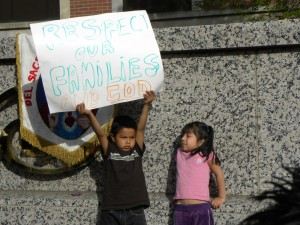Nearly a quarter of all babies born in the United States are now Hispanics, yet many of these newborns start life’s race behind the starting line, poor and disadvantaged. This issue might seem relevant only to longstanding metropolitan gateways for new immigrants, such as San Diego, New York, Chicago, and Miami. But today it matters for rural areas and small towns as well, because new immigrants have spread out all over the United States. Hispanics account for more than half of all the nonmetropolitan population growth in the 2000s, and in many parts of rural America from Alabama to Nebraska, growing numbers of Hispanics provide a demographic lifeline to dying small towns. Yet disproportionate and growing numbers of immigrant Hispanic children are born into poverty, and the difficult circumstances they face from before birth through childhood profoundly influence their adult contributions to American society.
Poverty and Fertility in New Immigrant Destinations
The conventional view is that immigrants get jobs and build lives in established urban enclaves and then move on to attain better housing in nicer middle class suburban neighborhoods with more opportunities for their children. Today, however, the geographic spread of disadvantaged Hispanic populations from established gateways to new destinations in the South, Midwest, and inner West raises the possibility of persistently disadvantaged rural and small town ghettoes, where poverty is reinforced by newly arriving immigrants and the birth of many new babies.
-

Image by Fibonacci Blue via Flickr CC Childbearing among U.S. Hispanics is higher on average than among non-Hispanics – and is a driving force in making U.S. society more diverse, especially in new destination states and communities. Among Hispanics, the number of births per 1000 woman of reproductive age was 80.2 in 2010, well above the overall U.S. rate of 64.1 for non-Hispanic whites.
- Poverty rates are highest for the fastest-growing Hispanic groups, especially Mexicans. Today, over 5.4 million U.S. Latino children live in poverty. Latinos comprise 23.1 percent of all children, but 37.3 percent of America’s poor children.
- Childbearing is highest among Hispanic mothers who are poor, non-citizens, non-English speakers, and who have low levels of education. Poor infants arrive and grow up disproportionately in old and new destinations where Hispanics are concentrated.
Key Findings about Poverty among Hispanic Newborns
The release of the annual American Community Survey makes it possible for the first time to identify infants born into impoverished families. By linking newborn infants with data about the poverty status of their parents and households, we found important patterns:
- About two in five rural newborn Hispanic infants are poor. The same is true for a similar proportion of those born in new destination communities, towns and rural areas. Mexicans have the highest Hispanic poverty rates. However, overall, rural poverty rates remain lower among Hispanics than for other historically-disadvantaged minorities, including rural blacks (55.2 percent poor) and American Indians (46.6 percent poor). But rural Mexicans have the highest rates of Hispanic poverty.
- A remarkable 70 percent of all Hispanic infants today are born to mothers with a high school degree or less, and the poverty rate among the infants of these mothers is 42.9 percent.
- Larger shares of rural than urban Hispanic infants are born to teenage mothers (11.7 vs. 9.4 percent). But, more importantly, about one in four Hispanic newborn infants have mothers who began childbearing as teenagers.
- Poverty afflicts over half of all Hispanic infants born to single mothers (including both never-married and previously married mothers). Tellingly, about two-fifths of all Hispanic infants are born to single mothers, and out-of-wedlock childbearing frequently means newborns are poor.
- Nearly half of all rural Hispanic newborn infants have foreign-born mothers, and such newborns have a poverty rate of 43.8 percent. The share of newborns to foreign-born Hispanic parents is similar in rural and urban areas – and in fact many young, foreign-born, and disadvantaged, Hispanics with families moved directly to rural areas.
- Public cash assistance reaches only about 12 percent of poor Hispanic families with infants. However, about one-half of such families receive Food Stamps.

Why Poverty for Hispanic Newborns Matters
Children who develop in poverty from the time they are in their mothers’ wombs are at risk for setbacks or deficits in long term cognitive development – and of course that can affect how they grow up and what they achieve in American society. Our findings should cause concern, because newborn Hispanic infants – a large share of all U.S. newborns – frequently begin life well behind the starting line. Born to poor, disadvantaged mothers, many of them live in fast-growing rural towns where poverty is concentrated and supports are sufficiently sparse that many of these children may never catch up or realize their full potential.
Our results highlight the need for scholars to further investigate the intergenerational roots of Hispanic poverty and track the developmental and economic trajectories of newborn infants in the many communities into which immigrants are now moving. For poor Hispanic mothers and babies, investments in rural reproductive health services, prenatal care, and nutrition programs such as Food Stamps and the Women, Infants, and Children program can pay large dividends.Children who develop in poverty from the time they are in their mothers’ wombs are at risk for setbacks or deficits in long term cognitive development.Too often, scholars and policymakers have ignored immigrant poverty outside of metropolitan areas. But we must broaden our purview because, today, many of America’s poor Hispanic babies are growing up in new, nonmetropolitan communities where family and health services may be missing, inadequate, or in decline. Addressing the very real needs of these communities and their burgeoning numbers of poor Hispanic residents is vital for America’s future.
—
Read more in Daniel T. Lichter, Scott R. Sanders, and Kenneth M. Johnson, “Hispanics at the Starting Line: Poverty among Newborn Infants in Established Gateways and New Destinations.” Social Forces (2015).

 Research to Improve Policy: The Scholars Strategy Network seeks to improve public policy and strengthen democracy by organizing scholars working in America's colleges and universities. SSN's founding director is Theda Skocpol, Victor S. Thomas Professor of Government and Sociology at Harvard University.
Research to Improve Policy: The Scholars Strategy Network seeks to improve public policy and strengthen democracy by organizing scholars working in America's colleges and universities. SSN's founding director is Theda Skocpol, Victor S. Thomas Professor of Government and Sociology at Harvard University.